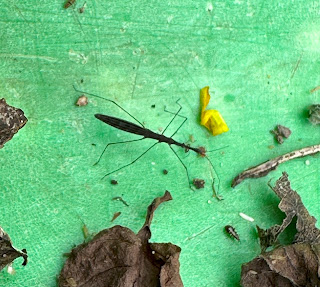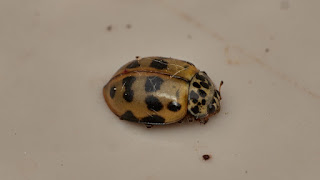Wednesday 26th July 2023, Apley Woods Local Nature reserve
This outing was a return to Apley Woods LNR in Telford. We were there in April when we spent most of our time in the woodland before finishing the day in the meadow. On this occasion we headed to the meadow and spent most of the day there.
As we gathered at the entrance to the site, we were joined by half a dozen of the Friends of Apley Woods. They accompanied us during the morning observing what we did, doing their own searching and seeking advice on species identification.
On the way to the meadow we walked down the edge of a grassland bordered by woodland. We could not wander past without being distracted.
A fly, possibly Dexiosoma caninum; there is a much rarer species that is very similar so we cannot be certain which species from the photograph.
 |
| Photograph: Nigel Cane-Honeysett |
A gall on the tip of a branch of a Yew, Taxomyia taxa, a midge.
 | |
| Photograph: John Lyden |
A colourful larva of a Grey dagger moth.
 |
| Photograph: David Williams |
And another gall, this time on oak, a Knopper gall, caused by the gall wasp, Andricus quercuscalicis.
 |
| Photograph: John Lyden |
If you look carefully at the last photograph, you will see a small insect on the oak leaf. This is a barkfly.
Many barkflies are identified easily by their wing pattern. This one is a very common species but, unfortunately, there are two species that look almost identical. These are Ectopsocus briggsi and petersi. They need close inspection to separate them which is not usually possible from a photograph. We have to resort to using the “aggregated” qualifier to say that it may be either! This is Ectopsocus briggsi agg.
Having reached the end of this first grassland we moved through a small formal lawned area to the meadow.
But we were delayed.
The trees surrounding the lawn attracted our attention.
Tucked under an oak leaf we found the distinctive sputnik-shaped egg-sac of the spider, Paidiscura pallens. The hole in the structure is the exit from where the offspring emerged.
 |
| Photograph: Nigel Cane-Honeysett |
And an Eyed ladybird, which is our largest species of ladybird, was dislodged from a tree.
 |
| Photograph: David Williams |
At long last (but still well before lunch) we made it to the meadow.
And where were we?
Here we are.
A third gall was noted, caused by a fly, Urophora cardui, on the host plant, Creeping thistle.
 |
| Photograph:John Lyden |
This was followed by the sighting of a large tachinid fly, Nowickia ferox,
 |
| Photograph: David Williams |
And a Nursery-web spider, Pisaura mirabilis, carrying her egg-sac.
 |
| Photograph: Nigel Cane-Honeysett |
It’s that time? How it flies. Where to have lunch?
The part of the meadow we were in was quite damp, we needed higher ground. On the other side of the meadow stood a large oak and we made our way to it and lunched in its shade.
Lunch over we stayed in the meadow and moved down to the area close to the main pool.
As we walked through the grass, we spotted several webs of labyrinth spiders.
 |
| Photograph: Nigel Cane-Honeysett |
Closer to the water’s edge we spotted a female Black-tailed skimmer,
 |
| Photograph: Black-tailed skimmer |
A Water measurer,
 |
| Photograph: Nigel Cane-Honeysett |
And a European cinchbug.
 |
| Photograph: Nigel Cane-Honeysett |
Moving away from the water, beating a pine tree dislodged a couple of ladybirds:
A Harlequin that had not yet to develop its spots;
 |
| Photograph: Nigel Cane-Honeysett |
And a Cream-streaked ladybird.
 |
| Photograph: David Williams |
Just as we were about to move to another area of the meadow one of the group found a creature on his bag. It was a Wasp-nest beetle.
 |
| Photograph: David Williams |
These seem to have a similar risky lifestyle to oil beetles.
Eggs are laid in autumn in decayed wood which hatch during spring or summer. The beetle larva awaits a visit by a wasp. When one does land on the wood the larva clings on to it and is transported back to the nest. There it will find and parasitise a wasp larva. The beetle pupates in the nest and emerges from it as an adult.
Moving into the woodland a nymph of a Woundwort shieldbug was photographed.
.JPG) |
| Photograph: John Lyden |
At this point we played a game of “hunt the pooter”.
A pooter had taken leave without permission. We sent out a search party to retrace our steps from when it had last been used.
It was not found …
We gave up looking and returned …
But wait …
There it was …
Peeking out of the undergrowth …
Not three feet from where we were standing ...
Pooter and owner were reunited ...
A happy ending.
The happy ending was short-lived as it started to rain heavily causing our rapid return to the comfort of our cars and homes.
The title?
When we visited in April, we were serenaded most of the time by a lone bagpiper who frequented the woods to practice.
He was not there for this visit.
He was missed!
Thank you to Telford and Wrekin Council and the Friends of Apley Woods for allowing us to enjoy ourselves, and to the photographers whose images illuminate this tale.
.JPG)
.JPG)


























No comments:
Post a Comment
Please feel free to comment on this post...